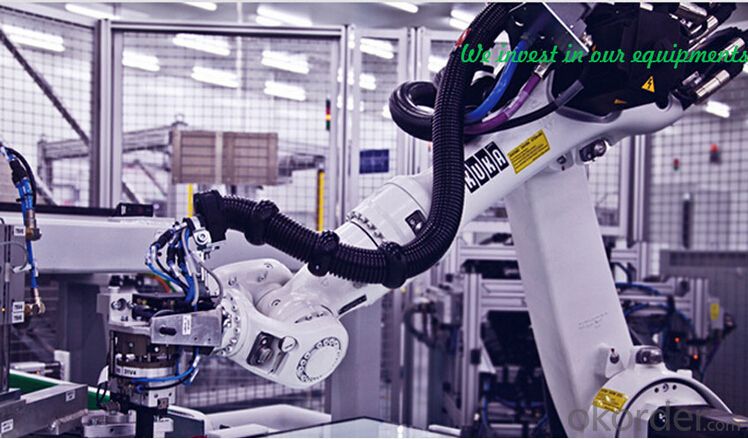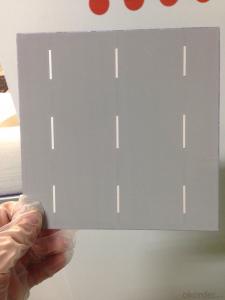High Efficiency And High Power Solar Cells
- Loading Port:
- Shanghai
- Payment Terms:
- TT OR LC
- Min Order Qty:
- 50000 pc
- Supply Capability:
- 2000000 pc/month
OKorder Service Pledge
OKorder Financial Service
You Might Also Like
Item specifice
Advantages of Monocrystalline Solar Cells
1. High efficiency and High power.
2. Long-term electrical stability.
3. Lowest price and Fastest delivery.
4. Good quality and good service.
5. Bulk supply
6. Good Warranty
7. Big Sale
8. More than 25 years on the lifetime.
Specifications of Monocrystalline Solar Cells
Format :125 mm × 125mm ± 0.5 mm
Thickness:210μm ± 40 μm
Front (-):1.5mm bus bars (silver),blue anti-reflection coating (silicon nitride)
Back (+):2.5mm wide soldering pads (silver) back surface field (aluminium)


Specifications of Poly Solar Cells
Format :156 mm × 156 mm ± 0.5 mm
Thickness:210μm ± 40 μm
Front (-):1.5mm bus bars (silver),blue anti-reflection coating (silicon nitride)
Back (+) : 2.5mm wide soldering pads (silver) back surface field (aluminium)
Temperature Coefficient of Monocrystalline Cells
Voc.Temp .coef.%/K:-0.351%/K
Isc.Temp .coef.%/K: +0.035%/K
Pm.Temp. coef.%/K: -0.47%/K
Usage and Applications of Monocrystalline Cells
Solar cells are often electrically connected and encapsulated as a module. Photovoltaic modules often have a sheet of glass on the front (sun up) side, allowing light to pass while protecting the semiconductor wafers from abrasion and impact due to wind-driven debris, rain, hail, etc. Solar cells are also usually connected in series in modules, creating an additive voltage. Connecting cells in parallel will yield a higher current; Our solar cells have passed IEC Certification. With high quality and stable quality. Our Cells can greatly improve the performance of Solar Modules.
Packaging & Delivery of Monocrystalline Cells
Carton Box Package and Deliver by air. It should be noticed that it should be avoid water, sunshine and moist.
FAQ:WHAT'S THE ADVANTAGES OF CNBM?
1.CNBM is a state-owned company under jurisdiction of central goverment , one of Fortune 500 .Just because of this ,we can get more support and resources from our government.So ,it is realiable .
2.CNBM's solar products are high-qualified with TUV,UL,VDE,CE,ISO certificates. Our products ranges top in China.
3.Just as I mentioned in attahment ,we signed 500MW project with Urkan under the witness of our chairman Xi Jinping ,CNBM has ability to meet your large quantity needs,Our annual capacity is 1GW.
4.We can offer you a competitive price .Because you are our potential and valued customer .
5.We ,CNBM ,has our own factory :CNBM JETION SOLAR .We can also customize according to customers' need . You can google our factory .
FAQ:Why install a Solar PV system?
There are many reasons to install a Solar PV system now:
As a low risk investment the returns of between 8-10% net are hard to beat especially during this financial downturn where bank interest rates are below inflation (i.e. money in a savings account even with interest added is actually reducing in value).
Its good for the environment. Installing a small domestic system of around 1.5 kW would provide around 1125 kWh of electricity every year, this would save around half a tonne of CO2 annually.
Electricity can be supplied at the point of use. Reducing strain on our national grid network.
The system will run silently and so will cause minimal disruption.
There is very little maintenance required for a PV system.
After the initial installation costs, there are no further fuel costs.
PV systems are modular, and can be added to at any time.
- Q:Can solar cells be used to power emergency lighting systems?
- Yes, solar cells can be used to power emergency lighting systems. Solar cells convert sunlight into electricity, which can be stored in batteries for later use. This makes them a reliable and sustainable source of power for emergency lighting, ensuring that they will continue to function even during power outages or other emergencies.
- Q:Can solar cells be used in theme parks or amusement parks?
- Yes, solar cells can be used in theme parks or amusement parks. Solar panels can be installed on rooftops, parking structures, or open areas within the park to generate renewable energy. This energy can be used to power rides, lighting, and other facilities, reducing reliance on traditional electricity sources and lowering operating costs. Additionally, incorporating solar technology aligns with the sustainable and eco-friendly image that many theme parks strive to promote.
- Q:How much maintenance do solar cells require?
- Solar cells require very little maintenance. They are designed to be durable and can typically last for decades with minimal upkeep. Routine maintenance may involve occasional cleaning to remove dust or debris that could affect their performance. Additionally, regular monitoring of the system's performance and checking for any potential issues is recommended. However, overall, solar cells are known for their low maintenance requirements, making them a reliable and cost-effective renewable energy solution.
- Q:Can solar cells be used for powering military bases?
- Yes, solar cells can definitely be used for powering military bases. Solar energy is a reliable and sustainable source of power that can be harnessed through the use of solar cells. Implementing solar panels on military bases can help reduce dependence on traditional fossil fuel-based energy sources, increase energy security, and provide a more environmentally friendly and cost-effective solution for powering military operations.
- Q:Can solar cells be used in extreme climates?
- Yes, solar cells can be used in extreme climates. While extreme heat or cold may slightly affect the performance of solar panels, modern solar technology is designed to withstand a wide range of temperatures. In fact, solar cells can even generate electricity in extremely cold conditions, such as snowy environments. Additionally, advancements in solar technology have made panels more resilient to extreme weather conditions like high winds or heavy rain.
- Q:I am working on research for the usage of solar cells, where can I find more news of solar cells?
- Solar daily is the website I used most when I need to get some news about the solar cells.
- Q:The history of solar cells
- Was first applied to cardiac pacemakers. As the lithium battery self-discharge rate is very low, the discharge voltage is gentle. Making the pacemaker implanted in the human body as long as possible. Lithium batteries are generally higher than the nominal voltage of 3.0 volts, more suitable for integrated circuit power. Manganese dioxide batteries, widely used in computers, calculators
- Q:Can solar cells be used to power electric vehicle charging stations?
- Yes, solar cells can be used to power electric vehicle charging stations. Solar panels convert sunlight into electricity, which can then be used to charge electric vehicles. This is known as solar-powered EV charging infrastructure, and it offers a sustainable and renewable energy solution for electric vehicle owners.
- Q:Can solar cells be used in healthcare facilities?
- Yes, solar cells can be used in healthcare facilities. They can help power various equipment and devices, such as lighting, ventilation systems, and medical equipment, reducing reliance on traditional energy sources and lowering operational costs. Additionally, solar power can be utilized in remote and off-grid healthcare facilities, ensuring access to clean and sustainable energy for essential healthcare services.
- Q:What is the impact of hailstorms on solar cells?
- Hailstorms can have a significant impact on solar cells. The high-speed impact of hailstones can cause physical damage, such as cracks or fractures, to the surface of solar panels. This can result in reduced efficiency and output of the affected solar cells. Additionally, hailstorms can also damage the protective layers on solar panels, increasing the risk of moisture ingress and potential corrosion. Therefore, hailstorms pose a potential threat to the durability and performance of solar cells.
1. Manufacturer Overview |
|
|---|---|
| Location | |
| Year Established | |
| Annual Output Value | |
| Main Markets | |
| Company Certifications | |
2. Manufacturer Certificates |
|
|---|---|
| a) Certification Name | |
| Range | |
| Reference | |
| Validity Period | |
3. Manufacturer Capability |
|
|---|---|
| a)Trade Capacity | |
| Nearest Port | |
| Export Percentage | |
| No.of Employees in Trade Department | |
| Language Spoken: | |
| b)Factory Information | |
| Factory Size: | |
| No. of Production Lines | |
| Contract Manufacturing | |
| Product Price Range | |
Send your message to us
High Efficiency And High Power Solar Cells
- Loading Port:
- Shanghai
- Payment Terms:
- TT OR LC
- Min Order Qty:
- 50000 pc
- Supply Capability:
- 2000000 pc/month
OKorder Service Pledge
OKorder Financial Service
Similar products
New products
Hot products
Related keywords




























